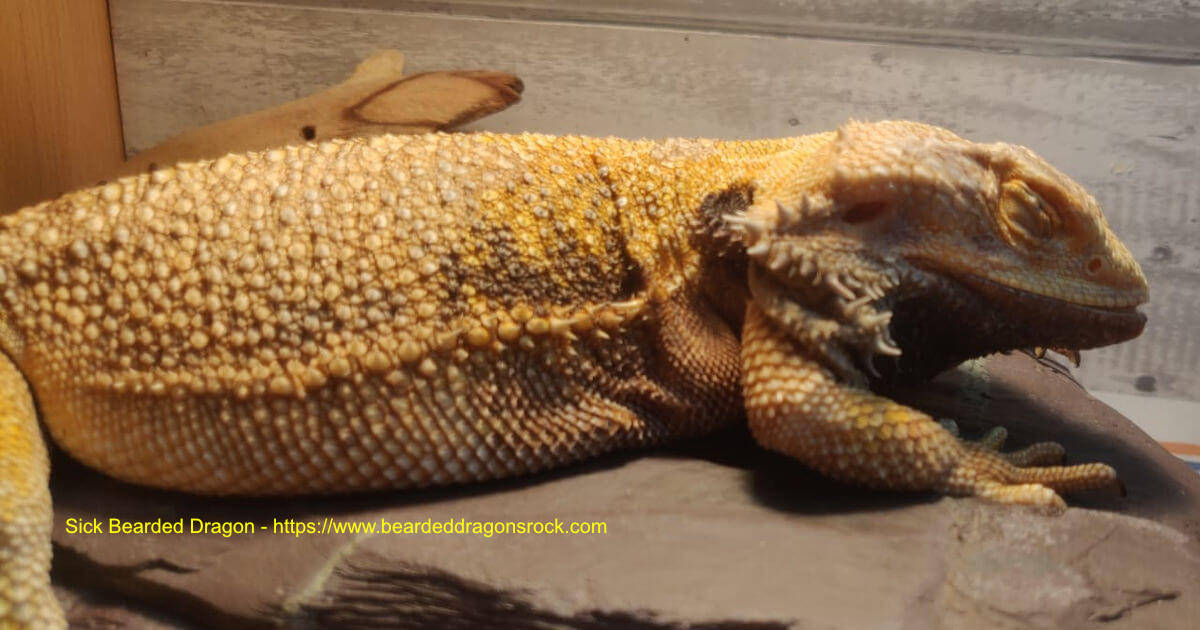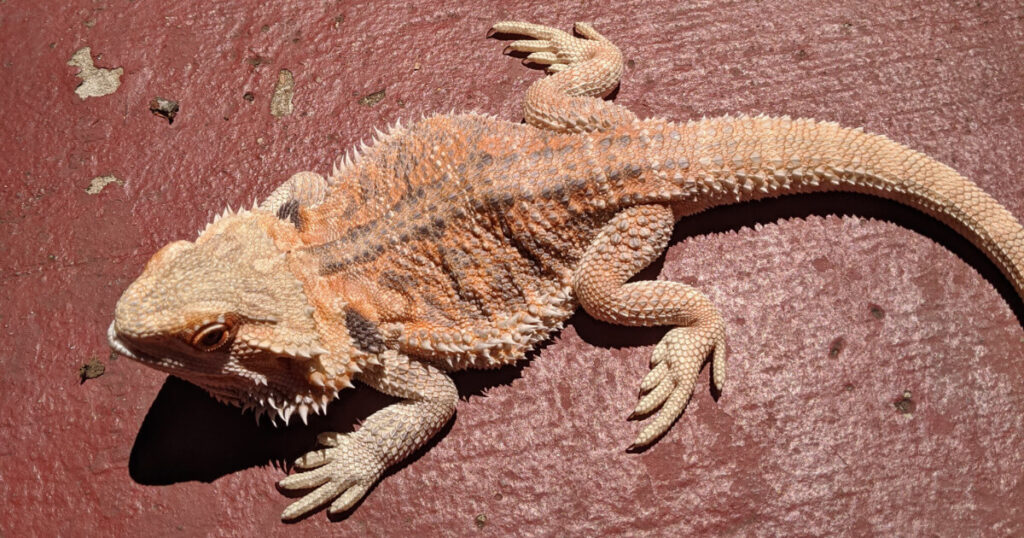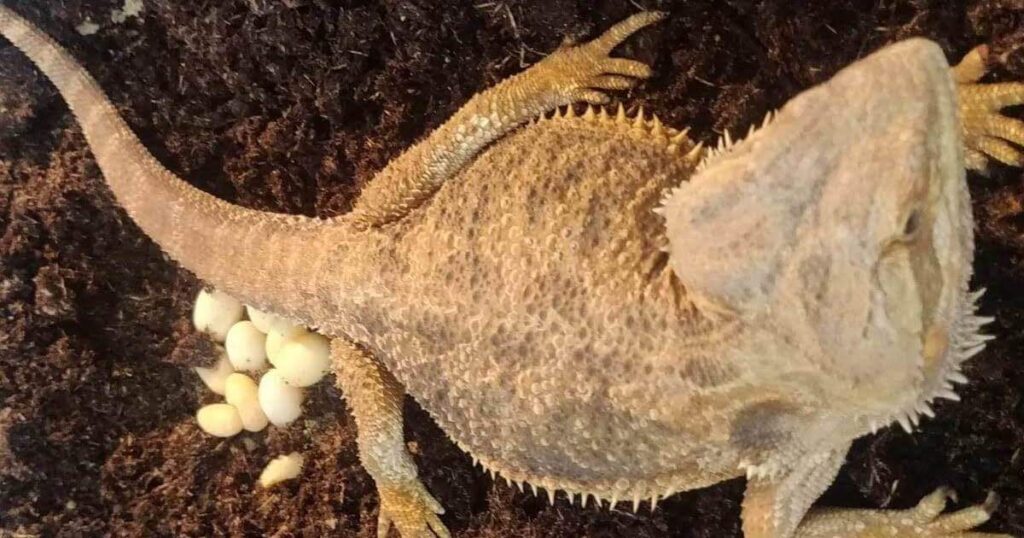Is Your Bearded Dragon Paralyzed?
Is your bearded dragon paralyzed? There are a number of things that can lead to a paralyzed bearded dragon and this post looks at those things and how to help your bearded dragon recover if possible.

Last Updated: November 22nd, 2021
By: Steve
Table of Contents
If your bearded dragon is not walking properly you can be forgiven for being quite anxious. A paralyzed bearded dragon is a very sick bearded dragon. There are a number of reasons that a bearded dragon can be paralyzed which we’ll go into in this article.
Usually, paralyzed bearded dragons present with their hind legs paralyzed. It’s rare, but not unheard of, for all four limbs to be paralyzed. Paralyzed bearded dragons with all four limbs paralyzed are at much greater danger of imminent death than those with just the hind limbs not functioning.
But make no mistake, a paralyzed bearded dragon is very likely to need specialist veterinary assistance and potentially lots of after care, regardless of whether it’s all four limbs or just the hind two.
What Can Make A Bearded Dragon Paralyzed?
Impaction
Impaction is one of the most common causes of paralysis in bearded dragons. We’ve classed it as impaction but the reality is a little more subtle. Although paralysis of a bearded dragon can occur through regular impaction (for more information about impaction itself, see our main Impaction article here) it’s more likely to be as a result of the bearded dragon eating something that’s too big for it.
Food Too Large
If the paralysed bearded dragon has eaten something that’s far too big and not chewed it up properly – which is very common in the bearded dragon world – then that item can compress on the spinal column as the large food item makes its way through the digestive system.
If it’s a standard impaction that’s occurred over multiple days that has caused the paralysis this will usually present as the rear legs of the bearded dragon paralysed. You can also expect that your bearded dragon will not have pooped for quite a while. They may look bloated and their back may be arched.
If it’s a sudden onset paralysis of your bearded dragon with previously normal toilet habits, but you know they’ve eaten something that’s too big for them then it may present as just the rear legs of the bearded dragon paralysed or all four limbs being paralysed.
Either of these scenarios are a medical emergency and you should consult with your reptile veterinary surgeon as soon as possible. If all four limbs are affected there’s a strong possibility that your bearded dragon will die, as the compression is high enough up the spinal column that even breathing may be inhibited. Explain the symptoms to your vet and ask for an emergency appointment. Surgery may be required.
Babies and Juvenile bearded dragons are more prone to being paralysed due to eating food that is too big for them. Pinkie mice can also be a cause of food based paralysis, since they are very large.
Genetic Obstruction
Not all food is to blame for making a bearded dragon paralysed. It’s quite possible that your bearded dragon has some previously unknown genetic abnormality that means the food doesn’t pass properly through their digestive system and ends up becoming obstructed. There’s not going to be all that much that can be done except perhaps surgery but your exotic reptile vet may have some treatments available so it’s worth contacting them.
Again, paralysis is a medical emergency for your bearded dragon, so contact the vet as soon as possible and explain what’s happened to them.
Metabolic Bone Disease (MBD)
If your bearded dragon isn’t getting enough calcium or Vitamin D then it could be struggling with Metabolic Bone Disease (MBD).
MBD manifests in a variety of ways, ranging from mild deformities due to soft bones, to major deformities of bone structures, uncontrollable tremors and/or seizures can occur and you can end up with a paralysed bearded dragon.

The paralysis due to MBD isn’t likely to be a sudden onset of a paralysed bearded dragon. It will occur over months or possibly even years. You’ll notice the tremors first, and the deformities. It’s at this point that you should take notice and consider the possibility of MBD. By the time MBD is causing a paralysed bearded dragon it’s going to be likely to be too late.
However, as with everything in this post, you should contact your expert reptile veterinary surgeon as MBD requires X-Rays and blood tests to accurately diagnose and depending on the severity the paralysis may possibly be reversed with calcium and D3 injections and some long term nursing care.
Egg Bound / Dystocia
This of course only applies to female bearded dragons, and only to female dragons who’ve become egg bound. If your bearded dragon appears to be pregnant / gravid (see our article on Gravid Bearded Dragons here) and doesn’t lay her eggs within a reasonable timeframe she may be egg bound.
We recently had to nurse one of our babies through this. We palliated her because she was too old to undergo surgery. The eggs became so big that they were in danger of compressing her spinal column. She was unable to eat for the latter part of her life, and while she remained comfortable we syringe fed her pureed food.
If your baby girl is egg-bound, it will require veterinary assistance from a vet who specialises in bearded dragons. There are remedies that can be considered before surgery become a necessity so talk to your vet early. We did, but unfortunately the remedies (including calcium shots, and sub-cutaneous hydration therapy) didn’t work. But we did get to nurse our little baby for nearly 4 months before she passed away peacefully at home.
If your bearded dragon is already paralysed due to being egg bound then other remedies will not be suitable and your vet should be consulted for possible surgery to remove the eggs.

Tumours
Talk of tumours is enough to scare anyone, but the reality is that a paralysed bearded dragon could have spinal tumours causing the problem. Unfortunately, there’s no way to know if tumours are the cause except for radiography imaging – which of course requires an exotic bearded dragon vet visit.
But if you’re certain that none of the other possible diagnoses fit, then you could be looking at tumours.
Hypervitaminosis D ( Over Calcification )
Few bearded dragon owners realise that bearded dragons can in fact be over-supplemented. Too much calcium, or more specifically too much Vitamin D can occur if bearded dragons are given too much supplement. UVB is by far the best way to make sure your bearded dragon is absorbing and using as much of that precious calcium as they can. The reason for this is that the bearded dragon’s endocrine system can manage the levels of Vitamin D appropriately this way. If the dragon has enough Vitamin D the skin will stop producing more in response to UVB. But if they are supplemented in their diet then this mechanism is short circuited.
Now, we’re not suggesting you shouldn’t supplement the bearded dragon’s D3. But we ARE saying be careful not to overdo it.
Too much calcium will lead to calcium deposits in the joints and potentially painful spurs. Spurs digging in to nerves causes lots of pain and pain reduces movement. If enough calcium is deposited into the joints they will eventually fuse and this can make your bearded dragon paralysed.
The only way to know if Hypervitaminosis D is the problem is to have a blood test by a reputable, qualified exotic bearded dragon Veterinary Surgeon.
Atadenovirus ( ADV )
Atadenovirus used to be believed to cause all sorts of neurological problems in bearded dragons, including potentially paralysis. However, more recent research indicates this is relatively unlikely. It’s quite a lengthy subject and we cover Atadenovirus in much more detail here.
Trauma
This is one of the most likely reasons for your bearded dragon to be paralysed. If they have fallen from a high place, or even not such a high place but have fallen very awkwardly, they could have sustained a traumatic spinal injury which can leave your bearded dragon paralysed.
If you find your bearded dragon in an awkward position (perhaps even upside down, on their back) and not moving their limbs or tail, then you can suspect a traumatic cause for this paralysis.
You’ll need to contact your exotic reptile vet for X-Rays and potential surgery.
Parasites
Whilst a parasitic infection is very unlikely to cause a paralysed bearded dragon directly, it can cause severe lethargy that may mimic paralysis. Parasites can also potentially cause impaction through either blocking the intestines themselves (if they’re worms for example that grow big enough) or by slowing down the gut movement and causing constipation and then impaction.
If your dragon is becoming lethargic, off their food, hiding in their cave more often or just generally unwell then, after checking their lights and heating, a parasite check with the local exotic reptile vet is usually the next thing to consider.
Osteoarthritis / Rheumatoid Arthritis
OA or RA cause inflammation of the joints, which if severe enough can mimic paralysis. This is for potentially two reasons. The first is that the joint can become fused and no longer function as a joint. If the joints all along the limb become fused, the dragon will appear paralysed.
The diagnosis of osteoarthritis or rheumatoid arthritis is, again, unfortunately going to need to be done by a qualified herpetology vet after ruling out other causes and potentially taking X-Rays or CT-scans.
Stroke
It’s not commonly known that reptiles can suffer from a stroke. But like humans (well, any vertebrate) reptiles blood can clot. This natural protective process is essential for stopping bleeding when the animal is injured, and is part of the normal healing process. But if blood can clot, sometimes, usually when the animal gets older, it can clot in the wrong place. If that clot occurs in the brain then a stroke occurs.
A stroke can very easily end up with your bearded dragon paralysed. Generally though, strokes in mammals at least tend to paralyse (if at all) only one side of the body. So if your bearded dragon is paralysed down one side of their body, with the other side functioning normally, then a stroke is a very likely suspect.
Of course, the other telltale signs associated with human stroke are largely useless when it comes to bearded dragons, since they are supremely unlikely to experience facial droop and can’t speak so their speech isn’t going to be affected. This leaves the limbs as we mentioned above.
If stroke is a cause of your bearded dragons paralysis you’ll need to consult with your exotic reptile vet to determine the likely prognosis (outcome). It’s unlikely that there’ll be any active treatment regime for a reptile, and the likelihood is that once a reptile has one stroke, it’s probably going to have more. But that’s a conversation for your vet. We’re not sure if anti-platelet or anti-coagulation therapy is available for bearded dragons!
Gout
Gout is an extremely painful condition, also seen in humans, caused by a build up of Uric Acid. Contrary to popular belief gout is not often caused by failing kidneys, but by an overload of uric acid. Certain foods break down creating more uric acid than others. Generally those foods are the live foods that bearded dragons eat. In humans, obesity is a major contributing factor to gout and in bearded dragons the same is true.
Bearded dragons become obese because they’re overfed and under exercised. Importantly, they’re overfed live food, and it’s live food that has the components that break down into Uric Acid.
Gout causes paralysis in bearded dragons because the uric acid build up crystallises in the joints and whilst the pain itself will reduce the movement of the bearded dragon, eventually the hard crystal build-up seizes the joints solid.
Preventing gout is extremely important to help prevent your bearded dragon becoming paralysed. Treatment options are limited if gout occurs, though speak to your exotic reptile vet for further advise on that. Preventing gout is generally a case of reducing the protein intake of your bearded dragon (see How Much Should I Feed My Bearded Dragon And When for more information), keep them well hydrated so the urates are passed, and keep them well exercised so they don’t become obese.
Final Words
As we’ve repeatedly stressed in this post, a paralysed bearded dragon is a veterinary emergency if it’s sudden onset. Even if it’s a gradual onset, you need to be contacting an exotic reptile specialist vet for further advice and management plans.
Some of the reasons for a bearded dragon being paralysed are preventable with good, proper husbandry (so make sure your heating and lighting is up to scratch). Many of the reasons are unfortunately likely to lead to your paralysed bearded dragon being euthanised.
If you find your bearded dragon paralysed, contact a vet straight away.
We hope it never happens to you or your beardie – but if you have experience of this and we’ve missed something please do feel free to leave a comment below and let us know.
